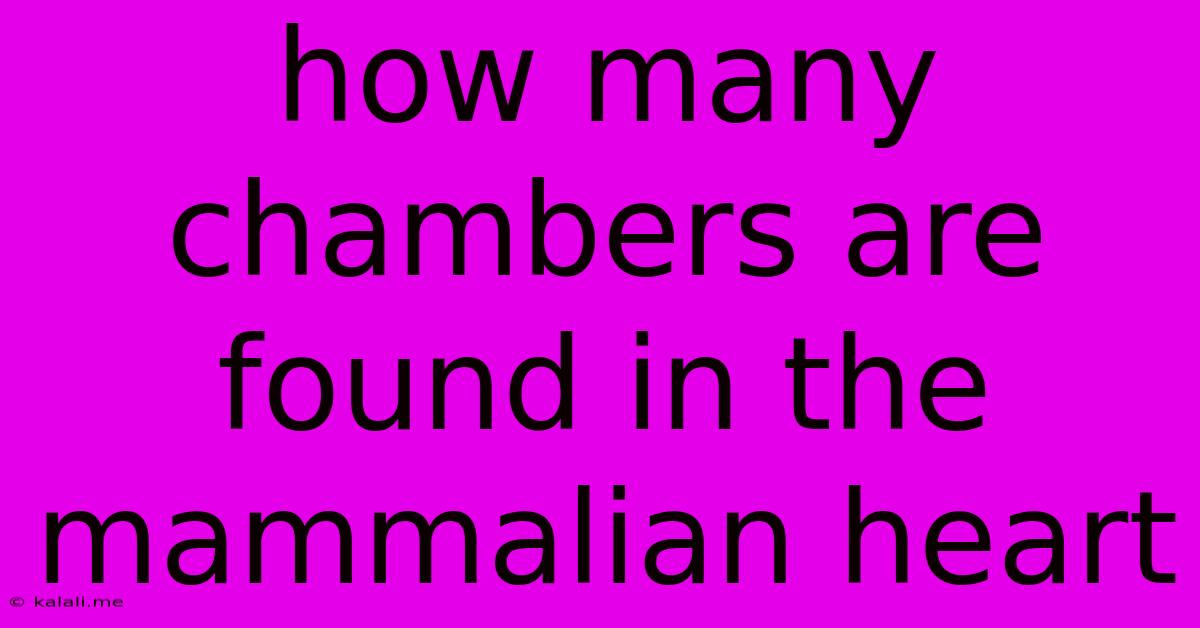How Many Chambers Are Found In The Mammalian Heart
Kalali
Jun 14, 2025 · 3 min read

Table of Contents
How Many Chambers Are Found in the Mammalian Heart?
The mammalian heart, a vital organ responsible for pumping blood throughout the body, is a marvel of biological engineering. A frequently asked question, especially in biology classes and anatomy studies, revolves around its structure: How many chambers does a mammalian heart have? The answer is straightforward: four. This efficient design ensures the separation of oxygenated and deoxygenated blood, a key factor in the high metabolic rates characteristic of mammals. This article will delve deeper into the structure and function of these four chambers.
The Four Chambers: A Detailed Look
The mammalian heart comprises four distinct chambers: two atria and two ventricles. Understanding the role of each is crucial to grasping the heart's overall functionality.
-
Right Atrium: This upper chamber receives deoxygenated blood returning from the body via the superior and inferior vena cava. This blood is low in oxygen and high in carbon dioxide, having delivered nutrients and oxygen to the body's tissues.
-
Right Ventricle: The right atrium pumps the deoxygenated blood into the right ventricle. The right ventricle then pumps this blood into the pulmonary arteries, which carry it to the lungs for oxygenation. This process is known as pulmonary circulation.
-
Left Atrium: After the blood is oxygenated in the lungs, it returns to the heart via the pulmonary veins, entering the left atrium. This chamber now holds oxygen-rich blood ready for systemic circulation.
-
Left Ventricle: The left atrium pumps the oxygenated blood into the left ventricle, the heart's most muscular chamber. The left ventricle then forcefully pumps this oxygenated blood into the aorta, the body's main artery, initiating systemic circulation – delivering oxygen and nutrients throughout the body.
The Importance of the Four-Chambered Heart
The four-chambered design is crucial for efficient blood circulation and oxygen delivery. The separation of oxygenated and deoxygenated blood prevents mixing, ensuring that the body receives a constant supply of oxygen-rich blood. This efficient system supports the high metabolic demands of mammals, allowing for sustained activity and complex physiological processes. Animals with less efficient circulatory systems, such as those with three-chambered hearts (like amphibians and reptiles), often have lower metabolic rates and less sustained activity levels.
Comparing Mammalian Hearts to Other Vertebrates
It's important to note that not all vertebrates possess a four-chambered heart. Reptiles, for instance, generally have three chambers, while amphibians may have three or even two. The evolution of the four-chambered heart represents a significant evolutionary advancement, contributing to the success and diversity of mammals. The complete separation of oxygenated and deoxygenated blood streams is a key adaptation for supporting a high metabolic rate and active lifestyle.
Conclusion
In conclusion, the mammalian heart possesses four chambers – two atria and two ventricles – working in a coordinated manner to efficiently pump oxygenated and deoxygenated blood throughout the circulatory system. This sophisticated design allows for the high metabolic rates and active lifestyles characteristic of mammals, highlighting the crucial role of this remarkable organ in maintaining life. Understanding the structure and function of these four chambers is fundamental to appreciating the complexity and efficiency of mammalian physiology.
Latest Posts
Latest Posts
-
Provides Flexible Support Is What Tissue
Jun 15, 2025
-
Describe The Relationship Between Force Mass And Acceleration
Jun 15, 2025
-
Which Of The Following Statements About Average Speed Is Correct
Jun 15, 2025
-
What Is The Lcm Of 10 And 14
Jun 15, 2025
-
What Family Does Potassium Belong To
Jun 15, 2025
Related Post
Thank you for visiting our website which covers about How Many Chambers Are Found In The Mammalian Heart . We hope the information provided has been useful to you. Feel free to contact us if you have any questions or need further assistance. See you next time and don't miss to bookmark.